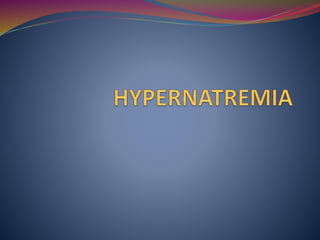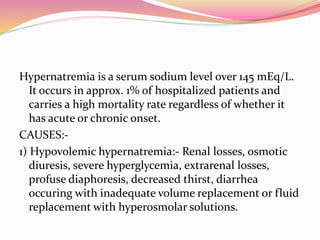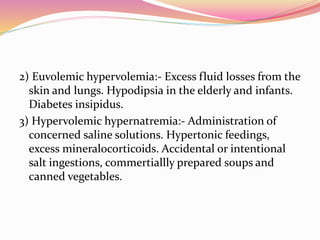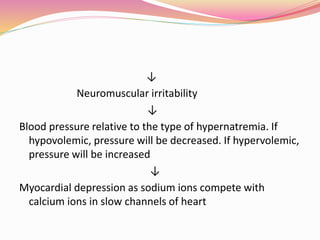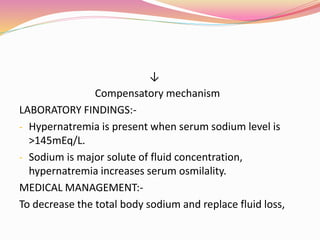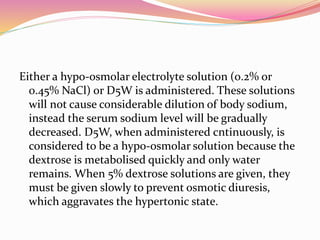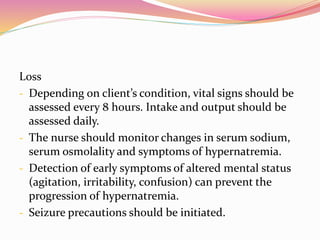Hypernatremia
- 2. Hypernatremia is a serum sodium level over 145 mEq/L. It occurs in approx. 1% of hospitalized patients and carries a high mortality rate regardless of whether it has acute or chronic onset. CAUSES:- 1) Hypovolemic hypernatremia:- Renal losses, osmotic diuresis, severe hyperglycemia, extrarenal losses, profuse diaphoresis, decreased thirst, diarrhea occuring with inadequate volume replacement or fluid replacement with hyperosmolar solutions.
- 3. 2) Euvolemic hypervolemia:- Excess fluid losses from the skin and lungs. Hypodipsia in the elderly and infants. Diabetes insipidus. 3) Hypervolemic hypernatremia:- Administration of concerned saline solutions. Hypertonic feedings, excess mineralocorticoids. Accidental or intentional salt ingestions, commertiallly prepared soups and canned vegetables.
- 4. CLINICAL MANIFESTATIONS:- GI:- Anorexia, nausea, vomitting. Integumentary:- Skin dry and flushed, mucus membrane dry and rough, body temperature elevated. Neurologic:- Restlessness, agitation, irritability, lethargy, stupor, coma, Muscle twiching, tremor, hyper reflexia, seizures, rigid paralysis in late stages. Cardiovascular:- Tachycardia, hypotension or hypertension, erratic heart rate and blood pressure dependent on fluid status.
- 5. Renal:- Oliguria, dark and concentrated. PATHOPHYSIOLOGIC BASIS:- Fluid retension in gastric cells ↓ Decrease of interstitial fluid in tissues ↓ Less interstitial fluids to cool body by evaporation ↓ Neurologic symptoms are the result of cerebral cellular dehydration
- 6. ↓ Neuromuscular irritability ↓ Blood pressure relative to the type of hypernatremia. If hypovolemic, pressure will be decreased. If hypervolemic, pressure will be increased ↓ Myocardial depression as sodium ions compete with calcium ions in slow channels of heart
- 7. ↓ Compensatory mechanism LABORATORY FINDINGS:- - Hypernatremia is present when serum sodium level is >145mEq/L. - Sodium is major solute of fluid concentration, hypernatremia increases serum osmilality. MEDICAL MANAGEMENT:- To decrease the total body sodium and replace fluid loss,
- 8. Either a hypo-osmolar electrolyte solution (0.2% or 0.45% NaCl) or D5W is administered. These solutions will not cause considerable dilution of body sodium, instead the serum sodium level will be gradually decreased. D5W, when administered cntinuously, is considered to be a hypo-osmolar solution because the dextrose is metabolised quickly and only water remains. When 5% dextrose solutions are given, they must be given slowly to prevent osmotic diuresis, which aggravates the hypertonic state.
- 9. Normal saline is used for volume depleted patient to provide fluid resuscitation. The saline is hypotonic in comparison with the serum and, therefore, allows the sodium level to decrease slowly. If the serum sodium level is lowered too rapidly, fluid will shift from vascular space into cerebral cells, causing cerebral edema. Water replacement should be administered to reduce serum sodium levels not more than 2 mEq/L/hour for the first 48 hours.
- 10. PHARMACOLOGIC MANGEMENT Hypernatremia caused by sodium excess can be treated with D5W and a diuretic such as Frusemide. DIETARY MANAGEMENT:- - Restricted sodium in diet. - Patients with renal disease may need to have sodium intake resticted to 500-2000mg/day. - Fluids should be restricted.
- 11. NURSING MANAGEMENT Nursing diagnosis(1):- Hypernatremia r/t decreased thirst or excessive administration of salt solutions or impaired secretion of sodium and water. Planning:- The nurse will monitor the patient for response to IV fluids replacement of hypoosmolar electrolyte solutions, absence of signs and symptoms of hypernatremia and return of normal sodium level. Implementation:- Water and fluids should be offered frequently to elderly and to patients with debilitating diseases in order to prevent body fluid loss and
- 12. hypernatremia. - Increased fluid intake inpatients with congestive heart failure or severe rennal disease is usually contraindicated. - The nurse should encourage patients to drink decaffeinated fluids and to avoid alcohol. - Caffeinated fluids and alcohol increase fluid loss, which can result in an increase in serum sodium level. - Overconsumption of fruit juices can also increase fluid
- 13. Loss - Depending on client’s condition, vital signs should be assessed every 8 hours. Intake and output should be assessed daily. - The nurse should monitor changes in serum sodium, serum osmolality and symptoms of hypernatremia. - Detection of early symptoms of altered mental status (agitation, irritability, confusion) can prevent the progression of hypernatremia. - Seizure precautions should be initiated.
- 14. - Fluid replacement with or without sodium should be closely monitored by the nurse.olume of oral secretion - Nursing diagnosis(2):- Oral mucus membranes, altered r/t inadequate volume of oral secretions. - Planning:- Patient will have improved condition of oral mucus membrane, as evidenced by moist and intact oral mucus membranes, increased oral mucus membrane score on assessment tool, report on no oral discomfort, and ability to consume fluids without pain.
- 15. Implementation:- - The patient should be offered oral oral care every 2 hours with a non alcoholic mouth wash. - Lemon glycerin swabs should also be avoided because they dry the membranes and may cause pain. - A soft tooth brush should be used to prevent injury to mucosa. - Lips should be moistened with a water soluble lubricant. Cool, non acidic fluids such as apple juice are generally tolerated.
- 16. THANK YOU
